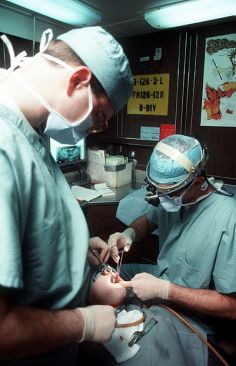The Medical Liability of the Mouth
By Steven Jaksha DMD
Published on July 5, 2018

There is a behemoth in the room that everyone is trying to ignore but if we are not careful, we’ll be crushed one day by this ignorance. We are all aware of some of the huge E. coli and Staph infections that create emergency room news headlines but are there other sources?
“Five dead, nearly 200 sick in E. coli outbreak from lettuce. And investigators are stumped”, read a recent news headline. E. coli (Escherichia coli) is a natural bacteria found in the intestinal gut for digestive purposes. The E. coli bacteria typically has had a bad reputation due to news reports where an E. coli poisoning occurred. For the most part, most E. coli strains live uneventfully in the guts of mammals helping to process food digestion at a microscopic level. At this activity level, there is a no-harm and the host benefits unless E. coli is found extra-intestinal i.e. outside its natural habitat, usually from contaminated food.
Pathogenic, extra-intestinal E. coli strains can cause a variety of septicemic illnesses creating conditions of vomiting, diarrhea, dysentery, neonatal meningitis and in some cases, kidney failure and even death. This is a great example of a bacteria when found in its natural location, is good and beneficial. When found extra-intestinal, very serious health issues can occur and potentially create professional and legal issues.
Staphylococcus is another bacterium that is part of our body’s normal bacteria flora commonly found in the nose, respiratory tract, and on the skin. When this bacterium is found in variant forms i.e. outside its normal flora location, very serious life-compromising infections can occur. Bacteria is an organism of “opportunity”. When found outside its normal flora location, infections and inflammation can occur at different levels of seriousness. Another news “bacteria-gone-awry” headline reads, “A MRSA Infection Cost Me $300,000—and Nearly Killed Me”, lends itself to the seriousness of bacteria outside its normal flora location. MRSA (Methicillin-resistant Staphylococcus aureus) is a serious staph infection. MRSA can cause infections in different parts of the body and since it is resistant to some commonly used antibiotics, it is tougher to treat than other Staphylococcus aureus strains. Depending on the location of the infection, the seriousness of MRSA symptoms can differ from visible skin infections or rash to headaches, muscle aches, chills, fever, fatigue, coughing, shortness of breath, and chest pain.
Similar to other bacteria, when this bacterium is found outside its intended and normal flora location, very serious health issues can arise, potentially creating enormous professional and legal issues. So where is this behemoth in the room that many are ignoring? Is it another bacterium?
With the trillions of natural bacteria that live harmoniously in and on our bodies, there are several billion doing the same in our mouths. Just like E. coli and the staphylococcus bacterium that can become “opportunistic” infections and inflammation, a significant amount of research (NIH, JP, JPR, JAMDA) is now indicating that there are several opportunistic oral bacteria related to several significant somatic systemic disease/illness conditions. Odontologists have long been aware of the oral-systemic disease/illness connection, but only recently has medical research demonstrated a causal link.
Even though the oral-systemic connection is not new, for many, it is hard to visualize. Perhaps this example will help. Imagine an unattended, palm-sized, purulent skin infection (MRSA?) on any limb of the body. This is a serious condition because it is creating an initial bacteremia often leading to a septicemia which would rightfully get the immediate medical treatment attention of any competent physician.
The tissue surrounding the oral dentition is estimated to have the same “palm-sized” surface area as described above, also sharing the same vascularity as any somatic wound site.
Unfortunately, the vast majority of practicing physicians fail to see and/or know how to properly diagnose any oral-dental related infections (periodontal disease). The seriousness of this is because it can adversely affect both the patient’s health, the physician’s practice and risk becoming a potential legal issue. Research is now demonstrating oral infection/inflammation vectors that can create or augment other very serious somatic conditions, worsening a physician’s patient health and welfare.
Imagine a pyretic fever patient with chronic, indefinite pain, lethargy, with an abnormal White Blood Cell (WBC) test supported with inflammation test bio-markers such as an ESR and CRP demonstrating an inflammation process but the initial visual physical examination shows nothing. Additional tests are taken, yet still no definitive cause-and effect diagnosis.
Ask yourself this: Has everyone looked everywhere? Has the mouth been over-looked? Is there an oral-periodontal infection? Has a simple PSR (Periodontal Screening and Recording) examination been performed? A PSR can be as simple as mandatory examination temperature recording. Had a proper oral-periodontal exam been performed as part of a medical examination, demonstrating an initial Class 3 or 6 periodontitis or ANUG, there would be a strong cause-and-effect for the abnormal WBC, ESR and CRP correlation allowing for a proper medical treatment action. Without properly examining and diagnosing the oral/periodontal tissue, a large potential infection site is being missed.
There are an estimated one billion bacteria living in the mouth at any one time with some 200-300 different types layered in the mouth-specific bio-film that starts in the mouth and continues throughout the digestive tract. In this bio-film flora, there are several bacteria types that localize themselves in periodontal disease creating oral health issues, but when these bacteria (Aggregatibacter actinomycetemcomitans, Porphyromonas gingivalis, Tannerella forsythia, Treponema denticola or Fusobacterium nucleatum) find themselves systematically via the vascular system they can potentially create numerous inflammatory disease or illness processes. Research indicates that these disease processes can manifest themselves in a higher percentage of patients as cardiovascular atherosclerosis, stroke, breast cancer, diabetic, and pregnancy complications.
It has been estimated that almost 50% of the United States general adult population has periodontal oral infections that rise to 70% of the 65 and older adult population. It is a good bet that 50% of patients in waiting in any medical reception area have an oral-periodontal infection potentially creating a systemic inflammatory process that will affect other systemic conditions and confound the treating physician. Additionally, the compromised health patient or the patient with an idiopathic inflammation process is at an even greater systemic risk when an undiagnosed oral infection is present. Failure to address this newly researched health aspect compromises both the patient and the treating physician. The question now is: Is there a behemoth lurking in your physician’s practice reception area?
The Author

Steven Jaksha DMD CDR DC USN (ret) Odontology, Oral Diseases, TMJ/TMD.
Article picture: A dental officer and his assistant remove the wisdom tooth of a crew member of the nuclear-powered aircraft carrier USS Dwight D. Eisenhower (CVN-69) during Fleet. Source: Wikipedia


